Rice Noodles Plant Based Diet
Vegan Singapore noodles are easy to make and can include lots of vegetables, making for a nutritious and flavorful meal. Its rice vermicelli noodles are gluten free and are loaded with delicious curry spice to create a delicious meal in less time than you might think.
While Singapore noodle recipes are not typically vegan or vegetarian friendly, you can add a boost of satisfying protein with either crumbled tofu or edamame. Both plant-based options taste great and will leave you feeling satisfied!
Skill: Easy | Time: 35 min |Servings: 4
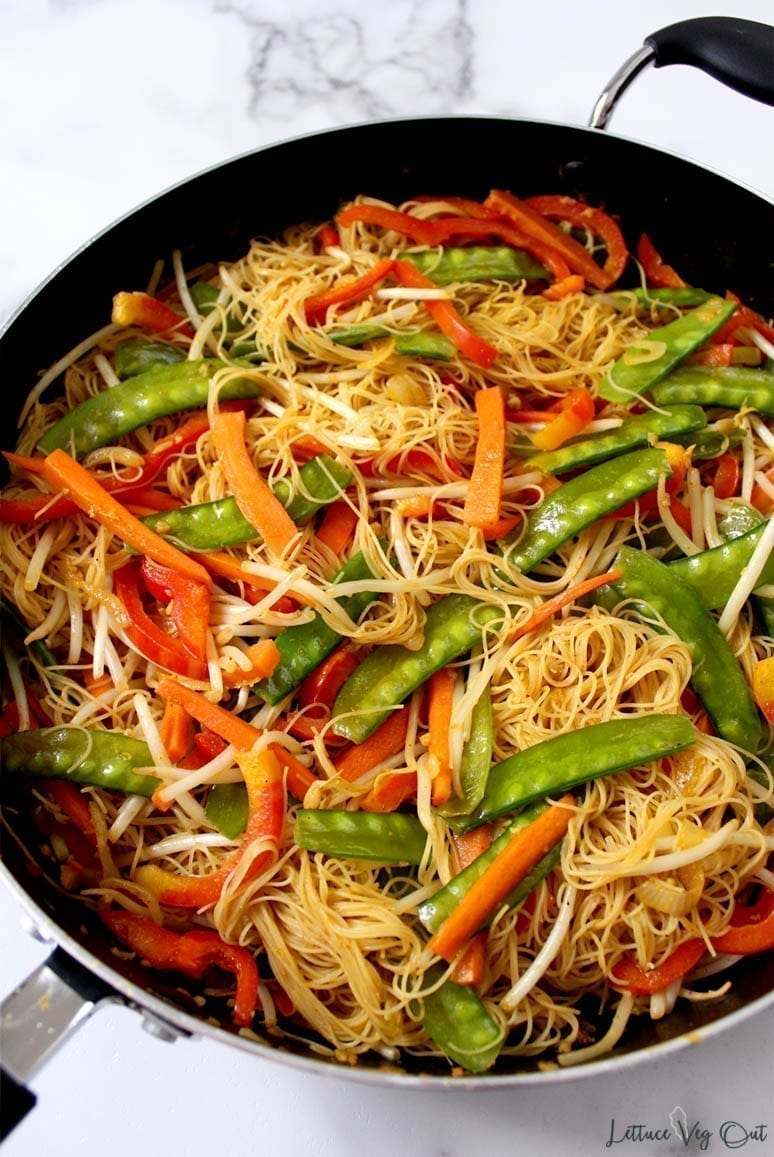
Get the Veg Out newsletter for new vegan recipes + nutrition content!
This post contains affiliate links (including Amazon Associates) and I earn from qualifying purchases.
Are Singapore Noodles Vegan? About Curry Rice Vermicelli
Where I live, "Singapore noodles" is used to describe a curry-flavored rice vermicelli dish. This often includes non-vegan ingredients like pork, shrimp or chicken, but it's a very simple recipe to make vegan.
Rice Vermicelli Noodles: Vegan and Gluten Free
Rice is gluten free and vegan, and vermicelli is a commonly used type of rice noodle. While there are many vegan rice vermicelli recipes available, making a curry-based Singapore noodles dish is quite common.
Rice itself is gluten free but often gets processed in facilities that handle gluten-containing grains. Brands of rice claiming to be gluten free likely process their rice in a strictly gluten-free space.
I use brown rice vermicelli noodles when I can find them, but they're hard to come by.
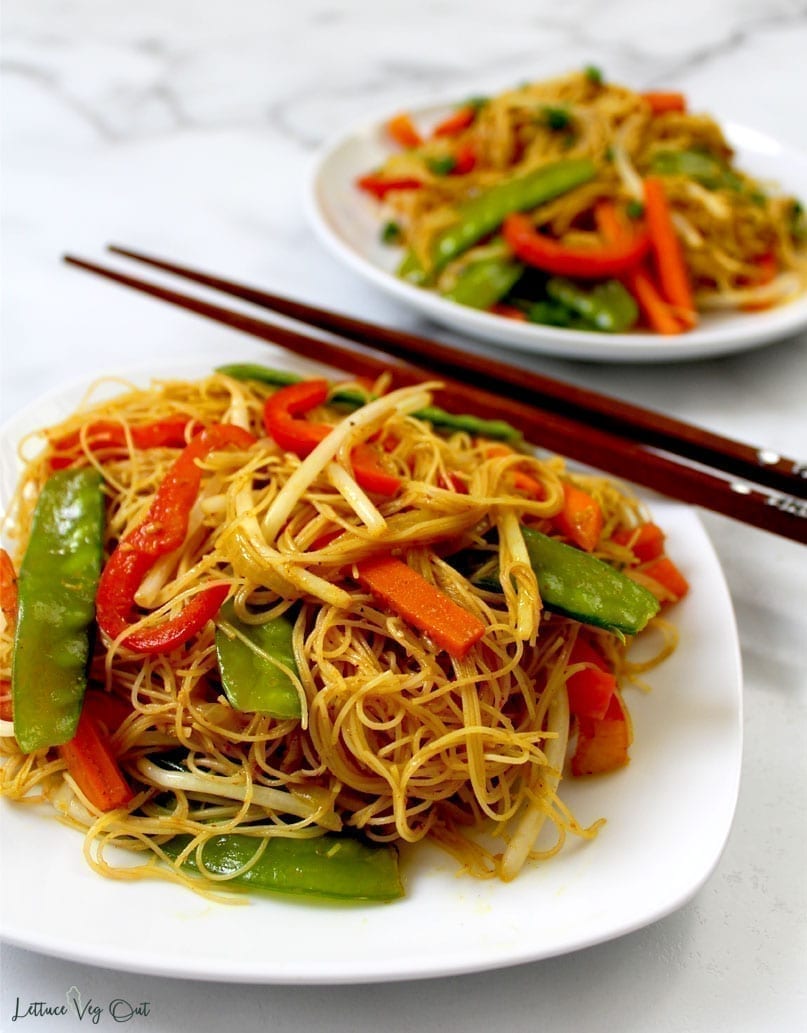
Vegan Singapore Noodles Sauce
I spent considerable time figuring out how to make this dish as flavorful as the non-vegan version. Animal sourced protein used in rice vermicelli recipes provide flavor that needs to be replaced in vegan recipes.
The key is in the sauce.
Using vegetable broth adds a lot of flavor and moisture. Tamari (or soy sauce if you're not gluten free) also provides a great depth of flavor and plenty of salt.
I've also included some sugar in the sauce. This really helps balance out the salt and the strong curry flavor, so I don't recommend leaving it out.
Any regular yellow curry powder should work. Different types will result in a unique flavor; I personally enjoy Jamaican-style curry powder.
Adding Plant-based Protein to Singapore Noodles
Made vegan, this recipe can be very low in protein. Two tasty ways to add vegan protein include:
- Shelled edamame. I always keep frozen edamame around, so cooking some in is simple (I add it at the same time as snow peas).
- Crumbled tofu or a side of tofu. You can easily prepare crumbled tofu with some extra sauce by sautéing it in the pan, remove, then begin with the rest of the recipe, adding the tofu back at the end.
A lower protein meal every now and again is fine, but without added protein, this won't be very filling. A well-balanced meal contains carbs, protein, fat and vegetables; this recipe checks of 3 of the 4, but protein is quite important for staying healthy as a vegan.
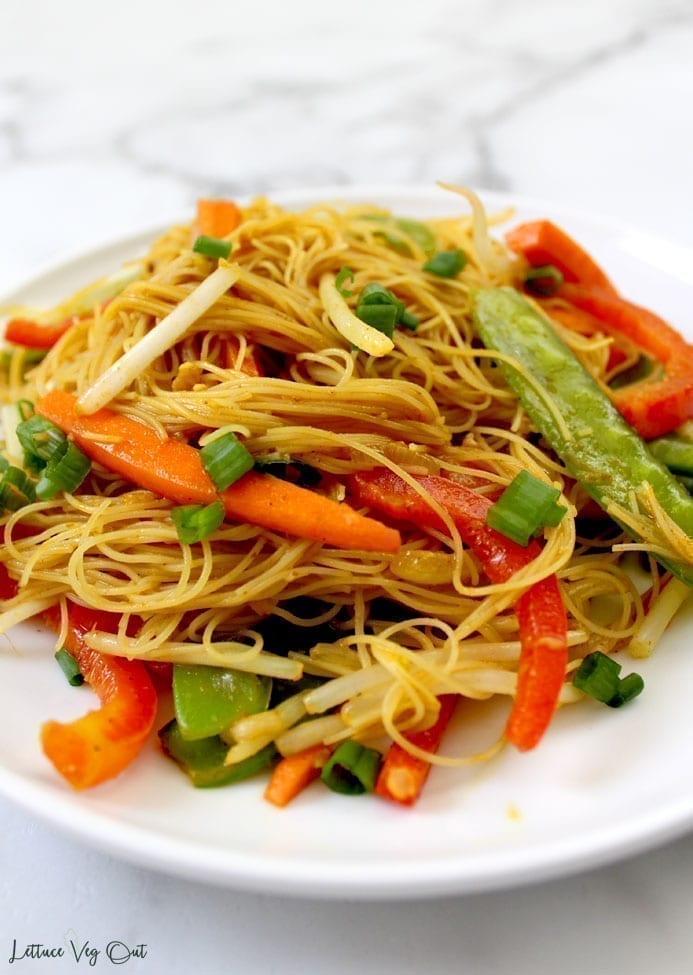
Ingredients to Make Vegan Singapore Noodles
As noted above, there's three main components of a flavorful and satisfying vegan Singapore noodles recipe. Rice vermicelli noodles, curry sauce and plant-based protein all work together to create a delicious Asian-inspired dinner that will delight you and/or your family.
The specific ingredients this recipe calls for include:
- Rice vermicelli noodles: Rice noodles will soak up your curry sauce and are the base of this recipe. Half of a standard size package is all you need for 4 servings.
- Carrots: Both in color and texture, some thinly sliced carrots add a lot of character to this recipe. You'll want to get these cooking in the pan with onions early in the process so they have time to cook properly (softened but still crisp).
- Bell peppers: For even more color and nutrition, bell pepper are a great vegetable to choose. I like to use red bell pepper but if you don't add another green vegetable to the dish then a green pepper may work better.
- Snow peas: Especially if you choose to use red, orange or yellow bell pepper, the nutrients and color contrast of green snow peas help enhance this recipe. Just remove their ends, wash thoroughly and add into the pan towards the end of cooking so they don't become mushy.
- Onion: I recommend adding onion into your pan first before any other vegetable. They take a bit of time to cook thoroughly but add lots of flavor to the recipe so onions are important to use!
- Garlic: 4-6 cloves of minced garlic enhanced flavor and creates a wonderful aroma as you cook. While this may sound like a lot, the curry taste will still be a primary feature of this recipe. Use as much or as little as you like; I'm a huge fan of lots of garlic so I don't hold back.
- Bean sprouts: To add a nice crunch and break up the texture from the rice vermicelli noodles, bean sprouts are a great addition. While they don't keep for long in the fridge (they need to be bought within a day or so of using), they make for an amazing extra vegetable. Don't worry if you don't have any, but I highly recommend you try adding them!
- Vegetable oil: When cooking vegetables on high heat, I recommend using a cooking oil like avocado oil to prevent sticking. Of course, oil will also improve the recipe's flavor and add some plant-based fat to the dish.
- Plant-based protein: As noted above, a vegan Singapore noodles recipe is typically stripped of protein that you'd find in non-vegan alternatives. Don't skip on protein as this meal will be less filling and satisfying; just add some plant-based protein! Crumbled tofu and/or edamame work well and can really improve your enjoyment while eating.
- Green onions: As an optional ingredient, sprinkle some green onions across the top of your plate when ready to serve. The dash of green contrasts the noodles and cooked vegetables quite nicely.
- Vegetable broth: As a base for the sauce, vegetable broth provides necessary liquid to have well-coated rice vermicelli noodles that don't taste dry. Aim for a no-salt-added broth since the tamari or soy sauce provides all the needed salt.
- Tamari (or soy sauce): For greater depth of flavor and more salt, use either tamari or soy sauce. Tamari will help maintain this recipe as gluten free, but if that's not important to you then soy sauce is fine.
- Sugar: Sugar is needed to balance out the salty rich flavors of tamari and curry powder.
- Curry powder: Depending on how strong you want the curry flavor to be, you can add more or less curry powder to the dish. I recommend between 2 ½ to 3 tablespoons, but as you make the recipe, make note of how much you want to achieve the best taste possible.
- Sesame oil: Like vegetables, your sauce could also use some oil to taste better and be more satisfying. Add a couple tablespoons for enhanced flavor and some healthy fats.
- Black pepper: While not much is added, black pepper is a staple ingredient in my kitchen. Sprinkle in a little bit for spice (and antioxidants).
Why this Recipe Works: Curry and Rice Vermicelli Noodles
While you could make an argument for any of the ingredients listed above as being "essential" for this recipe, Singapore noodles really relies on two ingredients. Curry, which is used to flavor the sauce, and vermicelli noodles which absorbs the sauce and mixes well with any of your vegetables.
There are so many types of curry powders available, from several brands that sell spices and seasonings. You may already have a preference; if you don't, I highly recommend experimenting to find which one works best for you, either specifically for this recipe or for anytime you need a curry flavor.
Likewise, not all rice vermicelli noodles are created equal. Vermicelli is just a style of noodle, and there are many types of rice that can be used when creating vermicelli. I try to purchase brown rice vermicelli noodles whenever I have a choice, but sometimes the grocery store I'm in does not have them. Any rice vermicelli noodle will provide a good result but find what works best for your tastes and nutrition preferences.
How to Make Vegetable Singapore Noodles: Instructions and Video Tutorial
To make vegan Singapore noodles, follow the easy steps below. Just pour boiling water on the rice vermicelli noodles, cook the vegetables, prepare your curry sauce, then stir fry all the components together and serve!
Step 1: Cook Vermicelli Noodles
It couldn't be much easier to cook rice vermicelli noodles, just place your desired amount in a bowl and pour boiling water over them. Toss these noodles around in the hot water until they start to absorb water and loosen from their original block shape.
After a couple minutes these should be soft and able to separate into individual strands. When they're ready, drain the water from the bowl or dump the noodles into a strainer so all you're left with is a pile of soft, ready-to-use rice vermicelli.
It's best to either dunk the strained noodles into a bath of ice water or rinse under cold water to stop the cooking process and ensure you don't end up with mushy noodles.
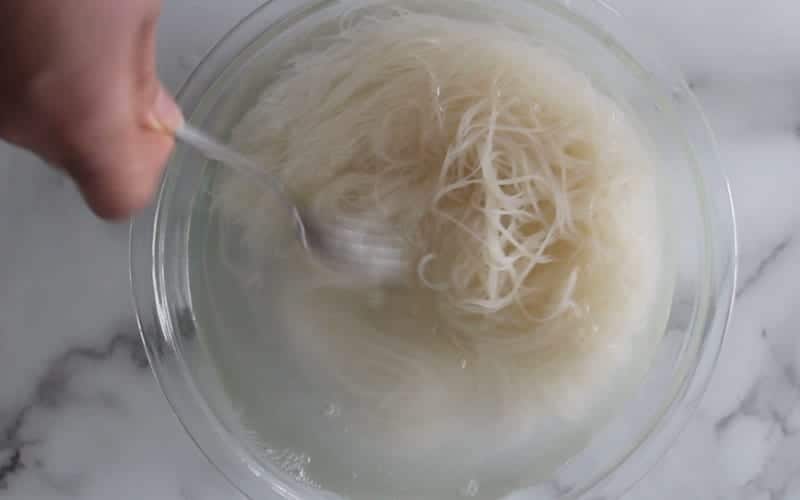
Step 2: Prepare Vegetables
While you can use whatever vegetables you prefer, the Singapore noodles recipe I create consistently uses onion, garlic, carrots, bell peppers, snow peas and bean sprouts. I also add them into the pan for cooking in this order.
Start by bringing the pan or wok to medium-high heat with cooking oil in the bottom. Then add the onion and use your cooking tongs, wooden spoon, or whatever instrument you use to break up the onion slices and allow it to cook down slightly. Once this starts to sizzle, add garlic and stir together.
When this begins producing a yummy aroma, add carrots and continue to stir until well mixed and the carrots begin to soften. Then add sliced bell pepper followed by snow peas. Once all these ingredients are tender (almost ready to eat), add the bean sprouts and mix thoroughly within your pan.
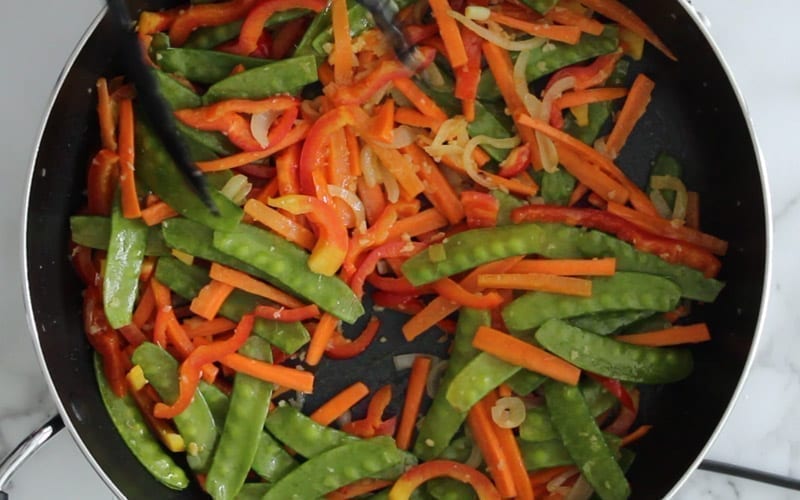
Step 3: Prepare Curry Sauce
As your vegetables cook (or before you start cooking, if you don't want to multi-task), combine the curry sauce ingredients. Either in a bowl or jar, mix vegetable broth, tamari or soy sauce, sugar, curry powder, sesame oil and black pepper.
With a bowl you'll either need to use a fork or a whisk to properly blend all these ingredients whereas if you add them to a jar you just need to put on its lid and shake until well mixed.

Step 4: Stir Fry
Once your vegetables are cooked and sauce mixed, you're ready to combine and stir fry. In the pan you cooked your vegetables in, add the noodles and sauce, stirring until you've reached an even consistency.
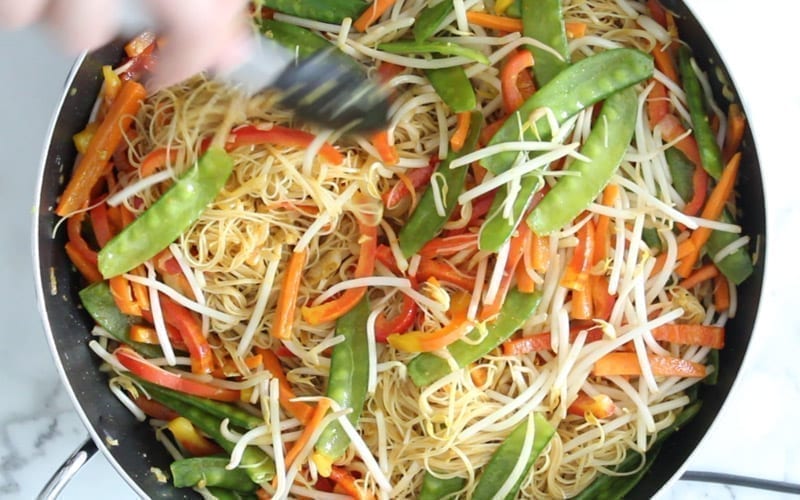
Step 5: Serve
When ready to serve, turn off the heat and use tongs to pull mixed ingredients out in even amounts.
I like to garnish Singapore noodles with chopped green onions and occasionally sesame seeds; you may want to do the same or top with another ingredient of your choice. If you like things spicy, hot sauce is a nice addition.
Finally, enjoy! While this is not a difficult recipe, you'll certainly be ready to dig in by the time you're done.

Curry Rice Vermicelli Substitutions and Variations
Above, I've thoroughly noted the two big options to customize your vegan Singapore noodles recipe. For a quick recap:
- Vegan protein sources: This meal is best enjoyed with vegan protein. My favorite two additions are either crumbled tofu or edamame. Have something else you'd prefer? Go for it and let me know what you choose in the comments section below!
- Gluten free sauce: The sauce ingredients should include either tamari or soy sauce. Use tamari if you want or need to keep this recipe gluten free, but if it doesn't matter to you then you'll likely prefer to use soy sauce.
How to Store Vegan Singapore Noodles: Refrigerating and Re-heating this Recipe
This recipe tends to make a large amount of Singapore noodles, which could lead to leftovers. If you still have vermicelli noodles and vegetables remaining after the initial meal, it's great to re-heat for lunch or dinner in the following days.
Simply fill an airtight container with leftover Singapore noodles and refrigerate for up to 5 days. If you leave them longer, the noodles will likely turn too mushy to enjoy, so eat within a few days.
When you're ready to re-heat, toss into the microwave and heat until a desired temperature is reached. While these can be enjoyed at room temperature or even cold, most people will prefer them warmed up.
I hope you enjoy this recipe! If you make it, please rate and comment below so others benefit from your experience.
More Vegan and Gluten Free Recipes
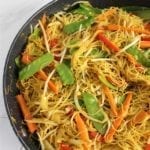
Print Pin
5 from 6 votes. Tried this recipe? Leave your review!
Vegan Singapore Noodles Recipe | Gluten Free
Enjoy this simple and tasty vegan Singapore noodle recipe anytime! With a delicious and flavorful sauce, these curry rice vermicelli noodles are a fantastic weeknight dinner.
Course Main Course
Cuisine Vegan
Keyword Gluten free Singapore noodles, vegan Singapore noodles
Prep Time 20 minutes
Cook Time 15 minutes
Total Time 35 minutes
Servings 4 Servings
Calories 334 kcal
-
Cutting Board
-
Knife
-
Large pan
-
Large bowl
-
Jar(s)
- 200 grams (7 oz) rice vermicelli noodles
- 1 ½ C carrots , thinly sliced (about 2 medium carrots)
- 1 ½ C bell peppers , thinly sliced (about 1 large; any color; I use red)
- 1 ½ C snow peas
- 1 C onion , thinly sliced (about 1 medium onion)
- 4-6 cloves garlic , minced
- 2 ½ C bean sprouts
- 2 tbsp oil (cooking oil for high heat; I like avocado oil)
- green onions , to serve (optional)
Sauce:
- 1 C vegetable broth
- 4 tbsp tamari (or soy sauce if not gluten free)
- 1 tbsp sugar
- 2-3 tbsp curry powder (I use a mild "Jamaican Curry" powder. If your curry powder is strong, start with 1 tbsp and add more as needed.)
- 2 tbsp sesame oil
- ½ tsp black pepper
-
Place the rice vermicelli noodles into a large bowl and cover with boiling water (can boil the water on the stove or in a kettle). Let sit until the noodles are softened, about 1 -2 minutes.
-
Strain away the hot water and rinse with cold water to stop the cooking process.
-
Prepare all the vegetables, as above.
-
Mix all the sauce ingredients together. I like to shake them in a glass jar.
-
Get all the vegetables, noodles and sauce ready next to a large pan or wok.
-
Heat the 2 tbsp cooking oil in the pan over medium-high heat.
-
Add the onion and sautee for 2 minutes, until it starts to turn transparent.
-
Next, add the garlic and cook for another minute.
-
Toss in the carrots and cook for 2 -3 minutes, until they start to soften. Then add the bell pepper for another 2-3 minutes.
-
Add the snow peas and toss around for another minute. Next, add noodles and sauce to the pan.
-
Toss everything around so the sauce and vegetables are well mixed into the noodles. Then add the bean sprouts, toss to combine, then turn the heat off and take the pan away.
-
Serve topped with green onion (optional).
Accuracy of nutrition information cannot be guaranteed (certain ingredients may not have all nutrients listed in the database); amounts may vary (and will vary depending on brands of ingredients used); all nutrition fact values rounded to the nearest whole number.
Serving: 1 Serving | Calories: 334 kcal | Carbohydrates: 43 g | Protein: 10 g | Fat: 15 g | Saturated Fat: 2 g | Polyunsaturated Fat: 4 g | Monounsaturated Fat: 8 g | Sodium: 787 mg | Potassium: 650 mg | Fiber: 9 g | Sugar: 13 g | Vitamin A: 11454 IU | Vitamin C: 84 mg | Calcium: 100 mg | Iron: 4 mg
Join the Community for Vegan Recipes
Source: https://lettucevegout.com/recipes/vegan-singapore-noodles/
0 Response to "Rice Noodles Plant Based Diet"
Post a Comment